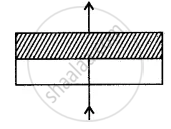Advertisements
Advertisements
Question
Show with the help of a ray diagram, the path of the ray when incident normally on the first surface of the glass block, through the block and the liquid.
Solution
We are assuming that the glass block is bounded by parallel plane refracting surfaces.

APPEARS IN
RELATED QUESTIONS
A lens forms an erect, magnified, and virtual image of an object. Where is the object placed in relation to the lens?
A lens forms an erect, magnified, and virtual image of an object. Name the device which uses this principle.
If the magnification produced by a lens is - 0.5, the correct statement is ______.
The focal length of a convex lens is 25 cm. At what distance from the optical centre of the lens an object be placed to obtain a virtual image of twice the size?
An illuminated object lies at a distance 1.0 m from a screen. A convex lens is used to form the image of the object on a screen placed at a distance of 75 cm from the lens. Find:
- the focal length of the lens, and
- the magnification.
An object is placed at a distance of 20 cm in front of a concave lens of focal length 20 cm. find: the magnification of image.
The magnification by a lens is +0.5. Name the lens and state how are u and v related?
How is the magnification (m) produced by a lens related to the object distance (u) and the image distance (v)?
An object is placed in front of a lens between its optical centre and the focus and forms a virtual, erect, and diminished image. Draw a ray diagram to show the formation of the image with the above-stated characteristics.
An erect, magnified, and a virtual image is formed when an object is placed between the optical centre and principal focus of a lens.
(i) Name the lens.
(ii) Draw a ray diagram to show the formation of the image with the above-stated characteristics.
